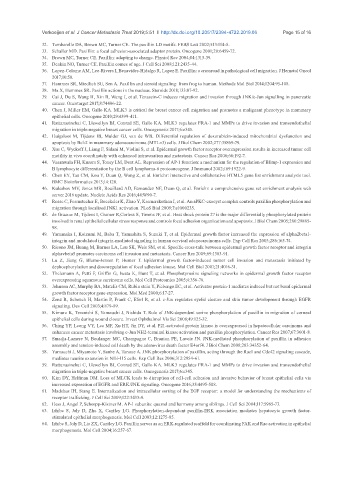Page 386 - Read Online
P. 386
Verkoeijen et al. J Cancer Metastasis Treat 2019;5:51 I http://dx.doi.org/10.20517/2394-4722.2019.06 Page 15 of 16
32. Tumbarello DA, Brown MC, Turner CE. The paxillin LD motifs. FEBS Lett 2002;513:114-8.
33. Schaller MD. Paxillin: a focal adhesion-associated adaptor protein. Oncogene 2001;20:6459-72.
34. Brown MC, Turner CE. Paxillin: adapting to change. Physiol Rev 2004;84:1315-39.
35. Deakin NO, Turner CE. Paxillin comes of age. J Cell Sci 2008;121:2435-44.
36. Lopez-Colome AM, Lee-Rivera I, Benavides-Hidalgo R, Lopez E. Paxillin: a crossroad in pathological cell migration. J Hematol Oncol
2017;10:50.
37. Hammes SR, Miedlich SU, Sen A. Paxillin and steroid signaling: from frog to human. Methods Mol Biol 2014;1204:95-108.
38. Ma X, Hammes SR. Paxillin actions in the nucleus. Steroids 2018;133:87-92.
39. Cai J, Du S, Wang H, Xin B, Wang J, et al. Tenascin-C induces migration and invasion through JNK/c-Jun signalling in pancreatic
cancer. Oncotarget 2017;8:74406-22.
40. Chen J, Miller EM, Gallo KA. MLK3 is critical for breast cancer cell migration and promotes a malignant phenotype in mammary
epithelial cells. Oncogene 2010;29:4399-411.
41. Rattanasinchai C, Llewellyn BJ, Conrad SE, Gallo KA. MLK3 regulates FRA-1 and MMPs to drive invasion and transendothelial
migration in triple-negative breast cancer cells. Oncogenesis 2017;6:e345.
42. Huigsloot M, Tijdens IB, Mulder GJ, van de WB. Differential regulation of doxorubicin-induced mitochondrial dysfunction and
apoptosis by Bcl-2 in mammary adenocarcinoma (MTLn3) cells. J Biol Chem 2002;277:35869-79.
43. Xue C, Wyckoff J, Liang F, Sidani M, Violini S, et al. Epidermal growth factor receptor overexpression results in increased tumor cell
motility in vivo coordinately with enhanced intravasation and metastasis. Cancer Res 2006;66:192-7.
44. Vasanwala FH, Kusam S, Toney LM, Dent AL. Repression of AP-1 function: a mechanism for the regulation of Blimp-1 expression and
B lymphocyte differentiation by the B cell lymphoma-6 protooncogene. J Immunol 2002;169:1922-9.
45. Chen EY, Tan CM, Kou Y, Duan Q, Wang Z, et al. Enrichr: interactive and collaborative HTML5 gene list enrichment analysis tool.
BMC Bioinformatics 2013;14:128.
46. Kuleshov MV, Jones MR, Rouillard AD, Fernandez NF, Duan Q, et al. Enrichr: a comprehensive gene set enrichment analysis web
server 2016 update. Nucleic Acids Res 2016;44:W90-7.
47. Rosse C, Formstecher E, Boeckeler K, Zhao Y, Kremerskothen J, et al. An aPKC-exocyst complex controls paxillin phosphorylation and
migration through localised JNK1 activation. PLoS Biol 2009;7:e1000235.
48. de Graauw M, Tijdens I, Cramer R,Corless S, Timms JF, et al. Heat shock protein 27 is the major differentially phosphorylated protein
involved in renal epithelial cellular stress response and controls focal adhesion organization and apoptosis. J Biol Chem 2005;280:29885-
98.
49. Yamanaka I, Koizumi M, Baba T, Yamashita S, Suzuki T, et al. Epidermal growth factor increased the expression of alpha2beta1-
integrin and modulated integrin-mediated signaling in human cervical adenocarcinoma cells. Exp Cell Res 2003;286:165-74.
50. Ricono JM, Huang M, Barnes LA, Lau SK, Weis SM, et al. Specific cross-talk between epidermal growth factor receptor and integrin
alphavbeta5 promotes carcinoma cell invasion and metastasis. Cancer Res 2009;69:1383-91.
51. Lu Z, Jiang G, Blume-Jensen P, Hunter T. Epidermal growth factor-induced tumor cell invasion and metastasis initiated by
dephosphorylation and downregulation of focal adhesion kinase. Mol Cell Biol 2001;21:4016-31.
52. Thelemann A, Petti F, Griffin G, Iwata K, Hunt T, et al. Phosphotyrosine signaling networks in epidermal growth factor receptor
overexpressing squamous carcinoma cells. Mol Cell Proteomics 2005;4:356-76.
53. Johnson AC, Murphy BA, Matelis CM, Rubin stein Y, Piebenga EC, et al. Activator protein-1 mediates induced but not basal epidermal
growth factor receptor gene expression. Mol Med 2000;6:17-27.
54. Zenz R, Scheuch H, Martin P, Frank C, Eferl R, et al. c-Jun regulates eyelid closure and skin tumor development through EGFR
signaling. Dev Cell 2003;4:879-89.
55. Kimura K, Teranishi S, Yamauchi J, Nishida T. Role of JNK-dependent serine phosphorylation of paxillin in migration of corneal
epithelial cells during wound closure. Invest Ophthalmol Vis Sci 2008;49:125-32.
56. Ching YP, Leong VY, Lee MF, Xu HT, Jin DY, et al. P21-activated protein kinase is overexpressed in hepatocellular carcinoma and
enhances cancer metastasis involving c-Jun NH2-terminal kinase activation and paxillin phosphorylation. Cancer Res 2007;67:3601-8.
57. Smadja-Lamere N, Boulanger MC, Champagne C, Branton PE, Lavoie JN. JNK-mediated phosphorylation of paxillin in adhesion
assembly and tension-induced cell death by the adenovirus death factor E4orf4. J Biol Chem 2008;283:34352-64.
58. Yamauchi J, Miyamoto Y, Sanbe A, Tanoue A. JNK phosphorylation of paxillin, acting through the Rac1 and Cdc42 signaling cascade,
mediates neurite extension in N1E-115 cells. Exp Cell Res 2006;312:2954-61.
59. Rattanasinchai C, Llewellyn BJ, Conrad SE, Gallo KA. MLK3 regulates FRA-1 and MMPs to drive invasion and transendothelial
migration in triple-negative breast cancer cells. Oncogenesis 2017;6:e345.
60. Kim DY, Helfman DM. Loss of MLCK leads to disruption of cell-cell adhesion and invasive behavior of breast epithelial cells via
increased expression of EGFR and ERK/JNK signaling. Oncogene 2016;35:4495-508.
61. Madshus IH, Stang E. Internalization and intracellular sorting of the EGF receptor: a model for understanding the mechanisms of
receptor trafficking. J Cell Sci 2009;122:3433-9.
62. Hess J, Angel P, Schorpp-Kistner M. AP-1 subunits: quarrel and harmony among siblings. J Cell Sci 2004;117:5965-73.
63. Ishibe S, Joly D, Zhu X, Cantley LG. Phosphorylation-dependent paxillin-ERK association mediates hepatocyte growth factor-
stimulated epithelial morphogenesis. Mol Cell 2003;12:1275-85.
64. Ishibe S, Joly D, Liu ZX, Cantley LG. Paxillin serves as an ERK-regulated scaffold for coordinating FAK and Rac activation in epithelial
morphogenesis. Mol Cell 2004;16:257-67.

